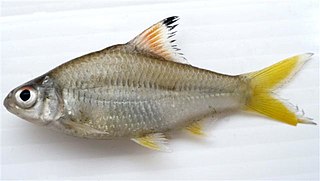
The International Union for Conservation of Nature (IUCN) Red List of Threatened Species, also known as the IUCN Red List or Red Data Book, founded in 1964, is an inventory of the global conservation status and extinction risk of biological species. A series of Regional Red Lists, which assess the risk of extinction to species within a political management unit, are also produced by countries and organizations.
Tropidophis greenwayi is a nonvenomous dwarf boa species endemic to the Caicos Islands. Two subspecies are currently recognized, including the nominate subspecies described here.

The bearded scrub robin, also known as the eastern bearded scrub robin, is a species of bird in the family Muscicapidae. It is found in eastern and southern Africa.
Greenway's grunter is a species of freshwater ray-finned fish, a grunter from the family Terapontidae. It is endemic to the northern part of Western Australia.
Gulella greenwayi is a species of very small air-breathing land snails, terrestrial pulmonate gastropod molluscs in the family Streptaxidae.
Lijndenia greenwayi is a species of plant in the family Melastomataceae. It is endemic to Tanzania.
Leiocephalus greenwayi, commonly known as the East Plana curlytail and the Plana Cay curlytail lizard, is a species of lizard in the family of curly-tailed lizards (Leiocephalidae). The species is native to the West Indies.

James Cowan Greenway was an American ornithologist. An eccentric, shy, and often reclusive man, his survey of extinct and vanishing birds provided the base for much subsequent work on bird conservation.
Laocypris is a monospecific genus of freshwater ray-finned fish belonging to the family Cyprinidae, the family which includes the carps, barbs, minnows and related fishes. The only species so far formally described in this genus is Laocypris hispida which is endemic to Laos, where there my be more than one species.

Mystacoleucus is a genus of freshwater ray-finned fish belonging to the family Cyprinidae, the family which includes the carps, barbs, minnows and related fishes. The fishes in this genus are found in Southeast Asia.
Neobarynotus is a monospecific genus of freshwater ray-finned fish belonging to the family Cyprinidae, the family which includes the carps, barbs, minnows and related fishes. The only species in the gneus is Neobarynotus microlepis which is found in Southeast Asia.
Scolichthys is a genus of poeciliid fishes endemic to river basins in Guatemala.

Mystacoleucus argenteus is a species of freshwater ray-finned fish belonging to the family Cyprinidae, the family which includes the carps, barbs, minnows and related fishes. This fish is found in Thailand and Myanmar in the drainage system of the Salween River.
Mystacoleucus ectypus is a species of cyprinid fish.
Mystacoleucus obtusirostris is a species of ray-finned fish, found in freshwater habitats in Southeast Asia, notably in Thailand in the Mekong River, Chao Phraya River, and Mae Klong River. It is exploited in subsistence fishing.
Mystacoleucus atridorsalis is a species of cyprinid in the genus Mystacoleucus. It inhabits the Mekong river and has a maximum length of 8.0 centimetres (3.1 in).
Mystacoleucus chilopterus is a species of cyprinid in the genus Mystacoleucus. It lives in Southeast Asia and has a maximum length of 9.1 centimetres (3.6 in). It is not considered threatened or endangered.
Mystacoleucus lepturus is a species of freshwater ray-finned fish belonging to the family Cyprinidae, the family which includes the carps, barbs, minnows and related fishes. It inhabits the Mekong and has a maximum length of 9.2 centimetres (3.6 in).

Mystacoleucus padangensis is a species of freshwater ray-finned fish belonging to the family Cyprinidae, the family which includes the carps, barbs, minnows and related fishes. It inhabits Sumatra, Indonesia, and has a maximum length of 11.6 centimetres (4.6 in).

Cola greenwayi, commonly known as hairy cola or Zulu coshwood, is a species of flowering plant in the family Malvaceae. It was first described in 1956 by the British botanist John Patrick Micklethwait Brenan. It is native to southeastern Africa.







